Impact of Financial Performance on CDS Score: A Detailed Analysis
VerifiedAdded on 2020/05/08
|14
|3073
|133
Report
AI Summary
This report presents an analysis of the relationship between Credit Default Swap (CDS) scores and the financial performance of 25 companies listed on the US stock market. The study employs inferential statistical techniques, including independent sample t-tests, correlation analysis, and regression analysis, to examine the impact of financial indicators such as EBITDA, market capitalization, Beta, and Earnings Per Share (EPS) on CDS scores. The results indicate a positive correlation between CDS scores and EBITDA, market capitalization, though these relationships are not statistically significant. The analysis also explores the influence of different sectors on CDS scores using ANOVA. Furthermore, the regression analysis reveals that the model explains only a small portion of the variance in CDS scores, possibly due to a small sample size and the influence of other unmeasured factors. The hypothesis testing confirms the positive, but not statistically significant, relationships between CDS and EBITDA and market capitalization. The report concludes with a discussion of limitations and suggestions for further research.

Chapter: 1 Results
Contents
Chapter: 1 Results.................................................................................................................................1
1.1 Data analysis (Inferential analysis)..............................................................................................1
1.2 Independent sample t test.............................................................................................................1
1.2.1 Correlation analysis.............................................................................................................5
1.2.2 Regression analysis..............................................................................................................7
1.3 Hypothesis testing......................................................................................................................10
1.4 Discussion..................................................................................................................................11
1.5 Limitations.................................................................................................................................12
1.6 Further Research........................................................................................................................12
Contents
Chapter: 1 Results.................................................................................................................................1
1.1 Data analysis (Inferential analysis)..............................................................................................1
1.2 Independent sample t test.............................................................................................................1
1.2.1 Correlation analysis.............................................................................................................5
1.2.2 Regression analysis..............................................................................................................7
1.3 Hypothesis testing......................................................................................................................10
1.4 Discussion..................................................................................................................................11
1.5 Limitations.................................................................................................................................12
1.6 Further Research........................................................................................................................12
Paraphrase This Document
Need a fresh take? Get an instant paraphrase of this document with our AI Paraphraser
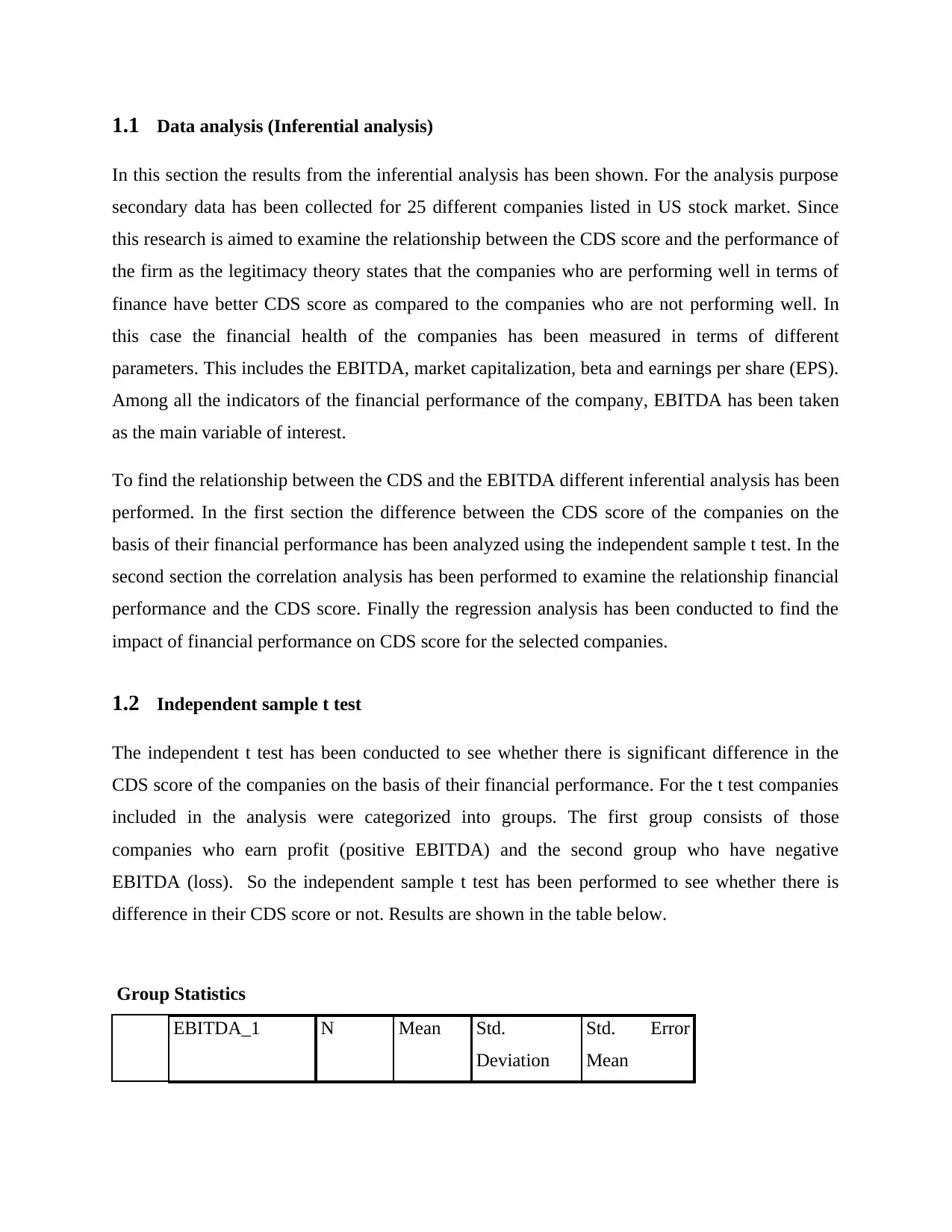
1.1 Data analysis (Inferential analysis)
In this section the results from the inferential analysis has been shown. For the analysis purpose
secondary data has been collected for 25 different companies listed in US stock market. Since
this research is aimed to examine the relationship between the CDS score and the performance of
the firm as the legitimacy theory states that the companies who are performing well in terms of
finance have better CDS score as compared to the companies who are not performing well. In
this case the financial health of the companies has been measured in terms of different
parameters. This includes the EBITDA, market capitalization, beta and earnings per share (EPS).
Among all the indicators of the financial performance of the company, EBITDA has been taken
as the main variable of interest.
To find the relationship between the CDS and the EBITDA different inferential analysis has been
performed. In the first section the difference between the CDS score of the companies on the
basis of their financial performance has been analyzed using the independent sample t test. In the
second section the correlation analysis has been performed to examine the relationship financial
performance and the CDS score. Finally the regression analysis has been conducted to find the
impact of financial performance on CDS score for the selected companies.
1.2 Independent sample t test
The independent t test has been conducted to see whether there is significant difference in the
CDS score of the companies on the basis of their financial performance. For the t test companies
included in the analysis were categorized into groups. The first group consists of those
companies who earn profit (positive EBITDA) and the second group who have negative
EBITDA (loss). So the independent sample t test has been performed to see whether there is
difference in their CDS score or not. Results are shown in the table below.
Group Statistics
EBITDA_1 N Mean Std.
Deviation
Std. Error
Mean
In this section the results from the inferential analysis has been shown. For the analysis purpose
secondary data has been collected for 25 different companies listed in US stock market. Since
this research is aimed to examine the relationship between the CDS score and the performance of
the firm as the legitimacy theory states that the companies who are performing well in terms of
finance have better CDS score as compared to the companies who are not performing well. In
this case the financial health of the companies has been measured in terms of different
parameters. This includes the EBITDA, market capitalization, beta and earnings per share (EPS).
Among all the indicators of the financial performance of the company, EBITDA has been taken
as the main variable of interest.
To find the relationship between the CDS and the EBITDA different inferential analysis has been
performed. In the first section the difference between the CDS score of the companies on the
basis of their financial performance has been analyzed using the independent sample t test. In the
second section the correlation analysis has been performed to examine the relationship financial
performance and the CDS score. Finally the regression analysis has been conducted to find the
impact of financial performance on CDS score for the selected companies.
1.2 Independent sample t test
The independent t test has been conducted to see whether there is significant difference in the
CDS score of the companies on the basis of their financial performance. For the t test companies
included in the analysis were categorized into groups. The first group consists of those
companies who earn profit (positive EBITDA) and the second group who have negative
EBITDA (loss). So the independent sample t test has been performed to see whether there is
difference in their CDS score or not. Results are shown in the table below.
Group Statistics
EBITDA_1 N Mean Std.
Deviation
Std. Error
Mean
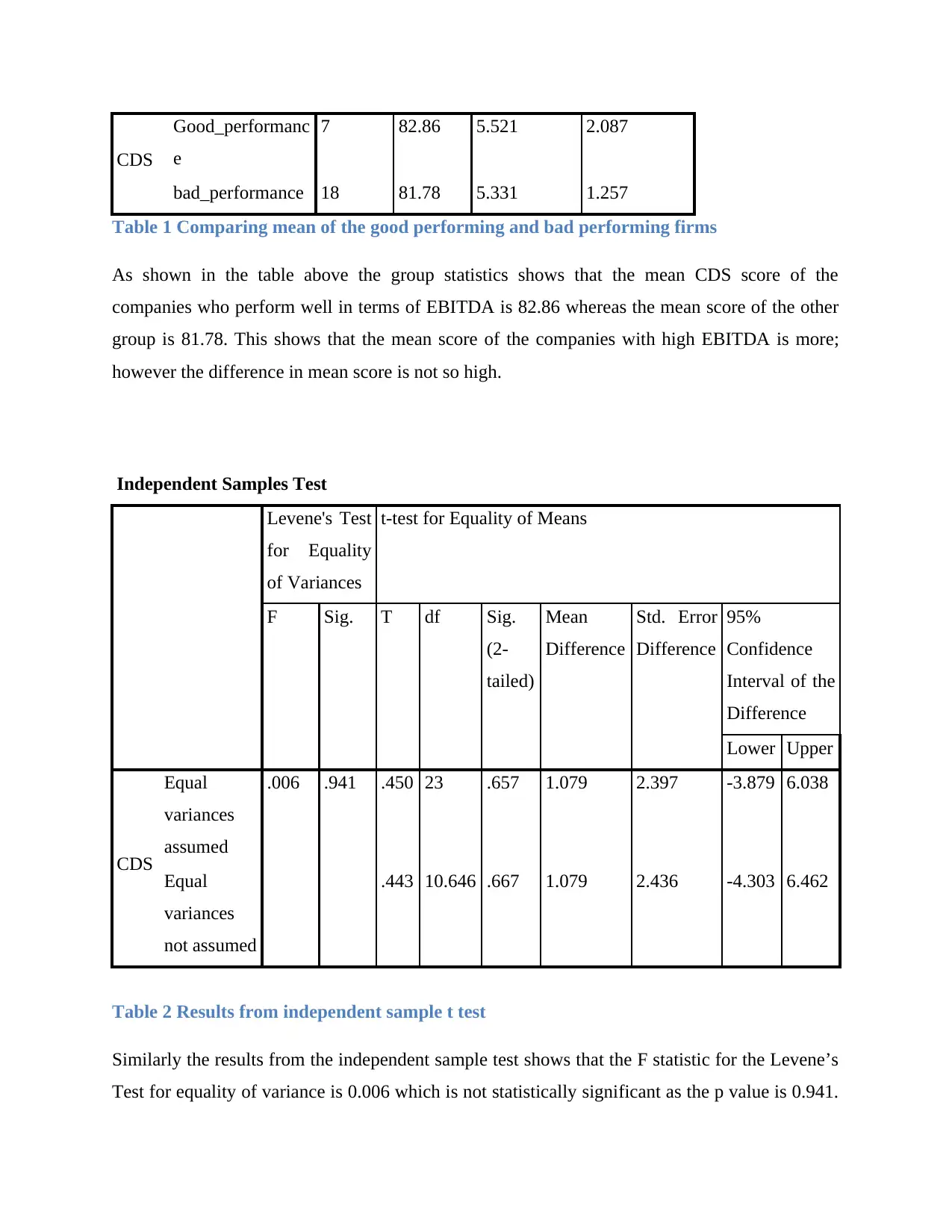
CDS
Good_performanc
e
7 82.86 5.521 2.087
bad_performance 18 81.78 5.331 1.257
Table 1 Comparing mean of the good performing and bad performing firms
As shown in the table above the group statistics shows that the mean CDS score of the
companies who perform well in terms of EBITDA is 82.86 whereas the mean score of the other
group is 81.78. This shows that the mean score of the companies with high EBITDA is more;
however the difference in mean score is not so high.
Independent Samples Test
Levene's Test
for Equality
of Variances
t-test for Equality of Means
F Sig. T df Sig.
(2-
tailed)
Mean
Difference
Std. Error
Difference
95%
Confidence
Interval of the
Difference
Lower Upper
CDS
Equal
variances
assumed
.006 .941 .450 23 .657 1.079 2.397 -3.879 6.038
Equal
variances
not assumed
.443 10.646 .667 1.079 2.436 -4.303 6.462
Table 2 Results from independent sample t test
Similarly the results from the independent sample test shows that the F statistic for the Levene’s
Test for equality of variance is 0.006 which is not statistically significant as the p value is 0.941.
Good_performanc
e
7 82.86 5.521 2.087
bad_performance 18 81.78 5.331 1.257
Table 1 Comparing mean of the good performing and bad performing firms
As shown in the table above the group statistics shows that the mean CDS score of the
companies who perform well in terms of EBITDA is 82.86 whereas the mean score of the other
group is 81.78. This shows that the mean score of the companies with high EBITDA is more;
however the difference in mean score is not so high.
Independent Samples Test
Levene's Test
for Equality
of Variances
t-test for Equality of Means
F Sig. T df Sig.
(2-
tailed)
Mean
Difference
Std. Error
Difference
95%
Confidence
Interval of the
Difference
Lower Upper
CDS
Equal
variances
assumed
.006 .941 .450 23 .657 1.079 2.397 -3.879 6.038
Equal
variances
not assumed
.443 10.646 .667 1.079 2.436 -4.303 6.462
Table 2 Results from independent sample t test
Similarly the results from the independent sample test shows that the F statistic for the Levene’s
Test for equality of variance is 0.006 which is not statistically significant as the p value is 0.941.
⊘ This is a preview!⊘
Do you want full access?
Subscribe today to unlock all pages.

Trusted by 1+ million students worldwide
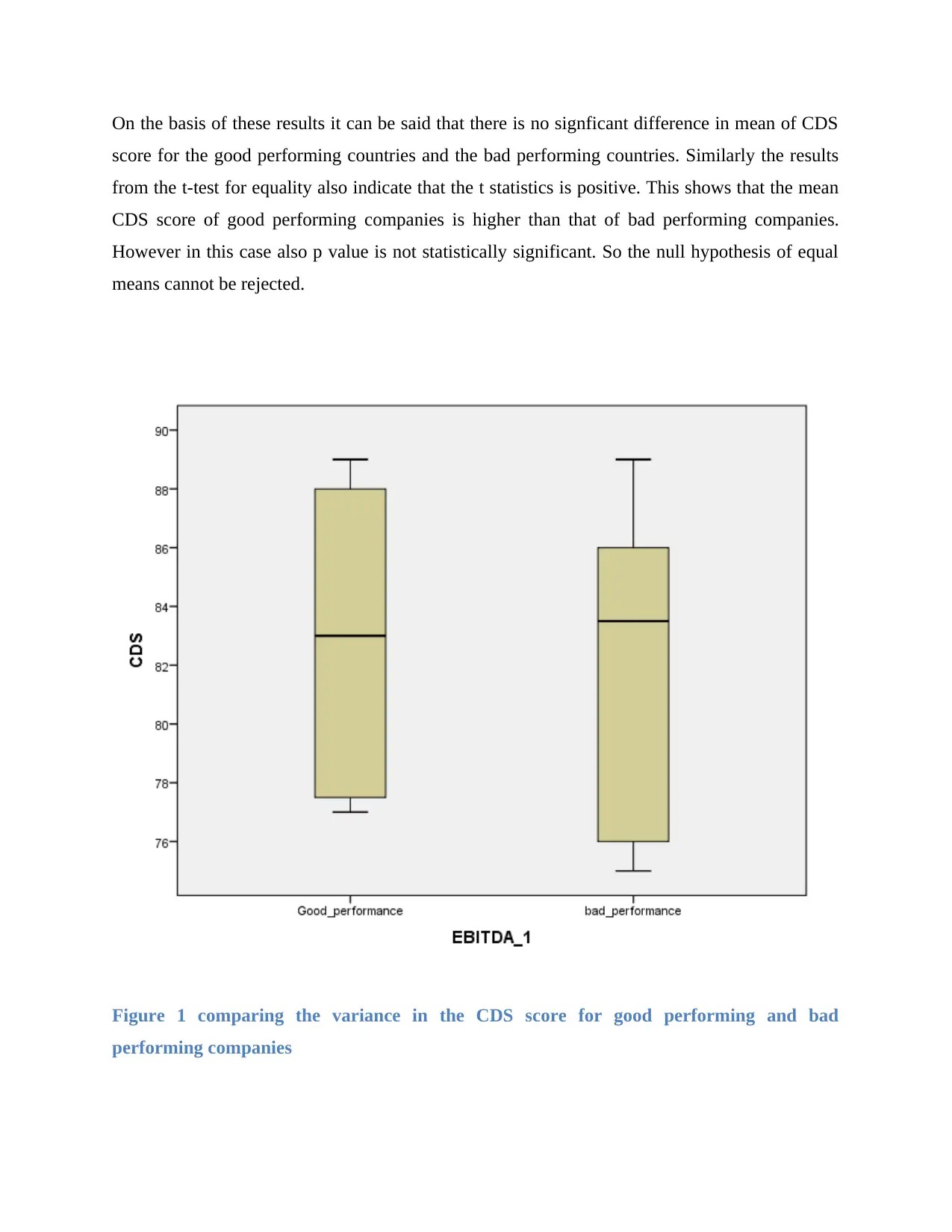
On the basis of these results it can be said that there is no signficant difference in mean of CDS
score for the good performing countries and the bad performing countries. Similarly the results
from the t-test for equality also indicate that the t statistics is positive. This shows that the mean
CDS score of good performing companies is higher than that of bad performing companies.
However in this case also p value is not statistically significant. So the null hypothesis of equal
means cannot be rejected.
Figure 1 comparing the variance in the CDS score for good performing and bad
performing companies
score for the good performing countries and the bad performing countries. Similarly the results
from the t-test for equality also indicate that the t statistics is positive. This shows that the mean
CDS score of good performing companies is higher than that of bad performing companies.
However in this case also p value is not statistically significant. So the null hypothesis of equal
means cannot be rejected.
Figure 1 comparing the variance in the CDS score for good performing and bad
performing companies
Paraphrase This Document
Need a fresh take? Get an instant paraphrase of this document with our AI Paraphraser
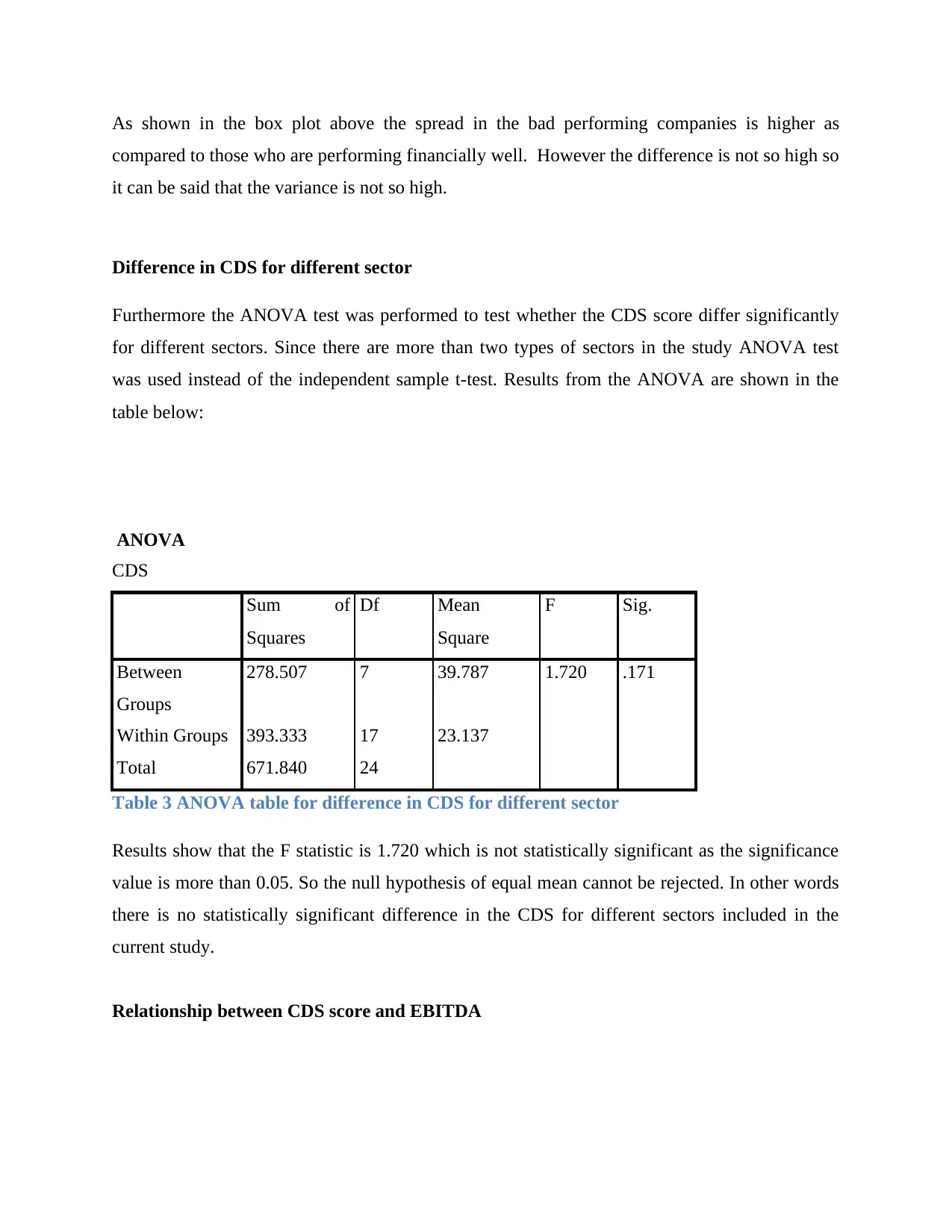
As shown in the box plot above the spread in the bad performing companies is higher as
compared to those who are performing financially well. However the difference is not so high so
it can be said that the variance is not so high.
Difference in CDS for different sector
Furthermore the ANOVA test was performed to test whether the CDS score differ significantly
for different sectors. Since there are more than two types of sectors in the study ANOVA test
was used instead of the independent sample t-test. Results from the ANOVA are shown in the
table below:
ANOVA
CDS
Sum of
Squares
Df Mean
Square
F Sig.
Between
Groups
278.507 7 39.787 1.720 .171
Within Groups 393.333 17 23.137
Total 671.840 24
Table 3 ANOVA table for difference in CDS for different sector
Results show that the F statistic is 1.720 which is not statistically significant as the significance
value is more than 0.05. So the null hypothesis of equal mean cannot be rejected. In other words
there is no statistically significant difference in the CDS for different sectors included in the
current study.
Relationship between CDS score and EBITDA
compared to those who are performing financially well. However the difference is not so high so
it can be said that the variance is not so high.
Difference in CDS for different sector
Furthermore the ANOVA test was performed to test whether the CDS score differ significantly
for different sectors. Since there are more than two types of sectors in the study ANOVA test
was used instead of the independent sample t-test. Results from the ANOVA are shown in the
table below:
ANOVA
CDS
Sum of
Squares
Df Mean
Square
F Sig.
Between
Groups
278.507 7 39.787 1.720 .171
Within Groups 393.333 17 23.137
Total 671.840 24
Table 3 ANOVA table for difference in CDS for different sector
Results show that the F statistic is 1.720 which is not statistically significant as the significance
value is more than 0.05. So the null hypothesis of equal mean cannot be rejected. In other words
there is no statistically significant difference in the CDS for different sectors included in the
current study.
Relationship between CDS score and EBITDA
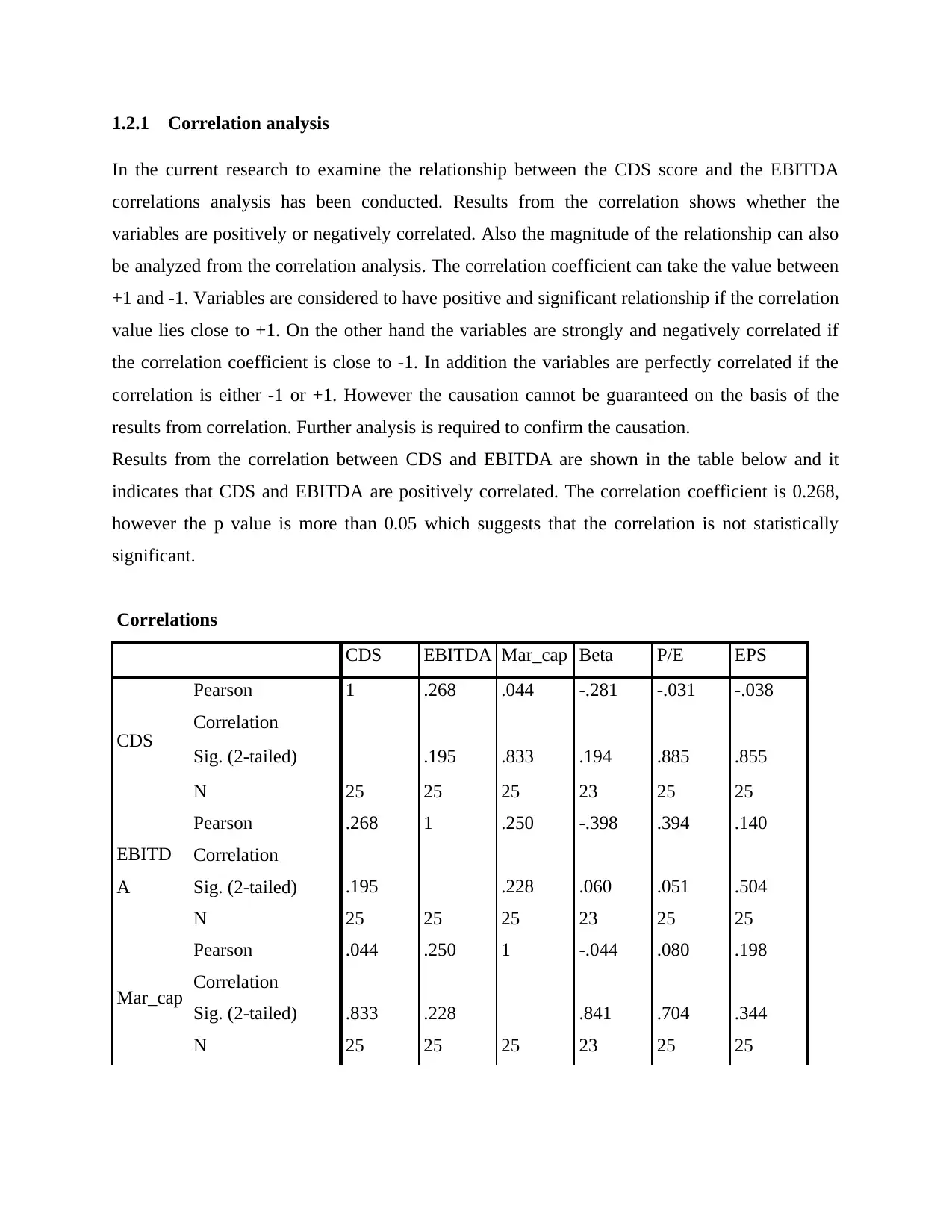
1.2.1 Correlation analysis
In the current research to examine the relationship between the CDS score and the EBITDA
correlations analysis has been conducted. Results from the correlation shows whether the
variables are positively or negatively correlated. Also the magnitude of the relationship can also
be analyzed from the correlation analysis. The correlation coefficient can take the value between
+1 and -1. Variables are considered to have positive and significant relationship if the correlation
value lies close to +1. On the other hand the variables are strongly and negatively correlated if
the correlation coefficient is close to -1. In addition the variables are perfectly correlated if the
correlation is either -1 or +1. However the causation cannot be guaranteed on the basis of the
results from correlation. Further analysis is required to confirm the causation.
Results from the correlation between CDS and EBITDA are shown in the table below and it
indicates that CDS and EBITDA are positively correlated. The correlation coefficient is 0.268,
however the p value is more than 0.05 which suggests that the correlation is not statistically
significant.
Correlations
CDS EBITDA Mar_cap Beta P/E EPS
CDS
Pearson
Correlation
1 .268 .044 -.281 -.031 -.038
Sig. (2-tailed) .195 .833 .194 .885 .855
N 25 25 25 23 25 25
EBITD
A
Pearson
Correlation
.268 1 .250 -.398 .394 .140
Sig. (2-tailed) .195 .228 .060 .051 .504
N 25 25 25 23 25 25
Mar_cap
Pearson
Correlation
.044 .250 1 -.044 .080 .198
Sig. (2-tailed) .833 .228 .841 .704 .344
N 25 25 25 23 25 25
In the current research to examine the relationship between the CDS score and the EBITDA
correlations analysis has been conducted. Results from the correlation shows whether the
variables are positively or negatively correlated. Also the magnitude of the relationship can also
be analyzed from the correlation analysis. The correlation coefficient can take the value between
+1 and -1. Variables are considered to have positive and significant relationship if the correlation
value lies close to +1. On the other hand the variables are strongly and negatively correlated if
the correlation coefficient is close to -1. In addition the variables are perfectly correlated if the
correlation is either -1 or +1. However the causation cannot be guaranteed on the basis of the
results from correlation. Further analysis is required to confirm the causation.
Results from the correlation between CDS and EBITDA are shown in the table below and it
indicates that CDS and EBITDA are positively correlated. The correlation coefficient is 0.268,
however the p value is more than 0.05 which suggests that the correlation is not statistically
significant.
Correlations
CDS EBITDA Mar_cap Beta P/E EPS
CDS
Pearson
Correlation
1 .268 .044 -.281 -.031 -.038
Sig. (2-tailed) .195 .833 .194 .885 .855
N 25 25 25 23 25 25
EBITD
A
Pearson
Correlation
.268 1 .250 -.398 .394 .140
Sig. (2-tailed) .195 .228 .060 .051 .504
N 25 25 25 23 25 25
Mar_cap
Pearson
Correlation
.044 .250 1 -.044 .080 .198
Sig. (2-tailed) .833 .228 .841 .704 .344
N 25 25 25 23 25 25
⊘ This is a preview!⊘
Do you want full access?
Subscribe today to unlock all pages.

Trusted by 1+ million students worldwide
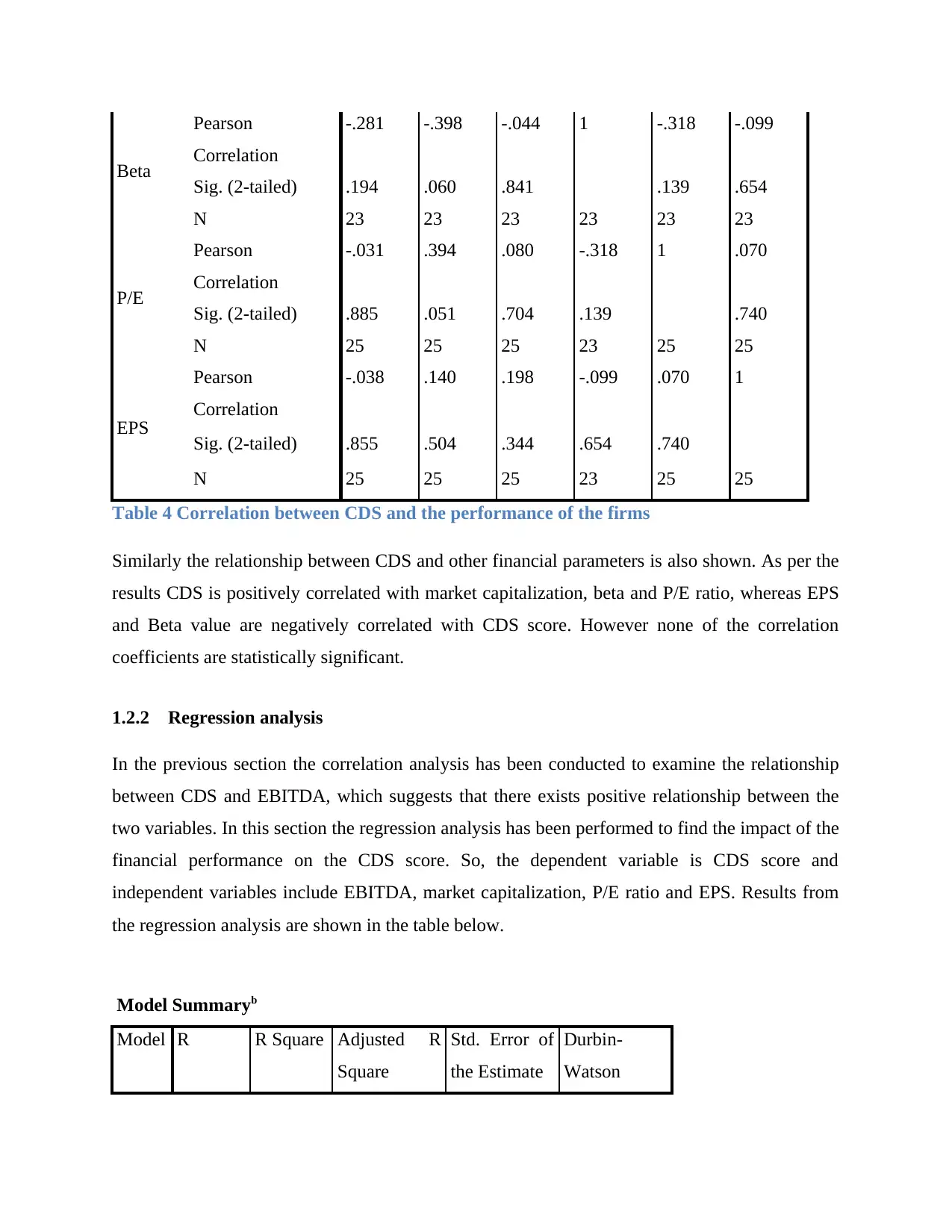
Beta
Pearson
Correlation
-.281 -.398 -.044 1 -.318 -.099
Sig. (2-tailed) .194 .060 .841 .139 .654
N 23 23 23 23 23 23
P/E
Pearson
Correlation
-.031 .394 .080 -.318 1 .070
Sig. (2-tailed) .885 .051 .704 .139 .740
N 25 25 25 23 25 25
EPS
Pearson
Correlation
-.038 .140 .198 -.099 .070 1
Sig. (2-tailed) .855 .504 .344 .654 .740
N 25 25 25 23 25 25
Table 4 Correlation between CDS and the performance of the firms
Similarly the relationship between CDS and other financial parameters is also shown. As per the
results CDS is positively correlated with market capitalization, beta and P/E ratio, whereas EPS
and Beta value are negatively correlated with CDS score. However none of the correlation
coefficients are statistically significant.
1.2.2 Regression analysis
In the previous section the correlation analysis has been conducted to examine the relationship
between CDS and EBITDA, which suggests that there exists positive relationship between the
two variables. In this section the regression analysis has been performed to find the impact of the
financial performance on the CDS score. So, the dependent variable is CDS score and
independent variables include EBITDA, market capitalization, P/E ratio and EPS. Results from
the regression analysis are shown in the table below.
Model Summaryb
Model R R Square Adjusted R
Square
Std. Error of
the Estimate
Durbin-
Watson
Pearson
Correlation
-.281 -.398 -.044 1 -.318 -.099
Sig. (2-tailed) .194 .060 .841 .139 .654
N 23 23 23 23 23 23
P/E
Pearson
Correlation
-.031 .394 .080 -.318 1 .070
Sig. (2-tailed) .885 .051 .704 .139 .740
N 25 25 25 23 25 25
EPS
Pearson
Correlation
-.038 .140 .198 -.099 .070 1
Sig. (2-tailed) .855 .504 .344 .654 .740
N 25 25 25 23 25 25
Table 4 Correlation between CDS and the performance of the firms
Similarly the relationship between CDS and other financial parameters is also shown. As per the
results CDS is positively correlated with market capitalization, beta and P/E ratio, whereas EPS
and Beta value are negatively correlated with CDS score. However none of the correlation
coefficients are statistically significant.
1.2.2 Regression analysis
In the previous section the correlation analysis has been conducted to examine the relationship
between CDS and EBITDA, which suggests that there exists positive relationship between the
two variables. In this section the regression analysis has been performed to find the impact of the
financial performance on the CDS score. So, the dependent variable is CDS score and
independent variables include EBITDA, market capitalization, P/E ratio and EPS. Results from
the regression analysis are shown in the table below.
Model Summaryb
Model R R Square Adjusted R
Square
Std. Error of
the Estimate
Durbin-
Watson
Paraphrase This Document
Need a fresh take? Get an instant paraphrase of this document with our AI Paraphraser

1 .381a .145 -.106 5.519 2.124
a. Predictors: (Constant), EPS, P/E, Mar_cap, Beta, EBITDA
b. Dependent Variable: CDS
Table 5 Model summary for the regression results
Results from the model summary show that R squared is only 0.145 which suggests that only
around 15 % variation in CDS is explained by the independent variables included in the data set.
The rest of the variation in the data set is due to some other factors. The low value of R squared
is because CDS score is affected by many other factors which are not included in the current
regression model as the independent variables. Also the sample size in the current research is less
than 30 which can be the possible reason behind such results. In addition the Durbin Watson
shows that there is no strong problem of autocorrelation in the variables as the DW test is close
to 2.
ANOVAa
Model Sum of
Squares
Df Mean
Square
F Sig.
1
Regression 88.013 5 17.603 .578 .716b
Residual 517.900 17 30.465
Total 605.913 22
a. Dependent Variable: CDS
b. Predictors: (Constant), EPS, P/E, Mar_cap, Beta, EBITDA
Table 6 ANOVA results for the regression results
Similarly the cumulative impact of the independent variables on the dependent variable is shown
by the F statistics in the ANOVA table. In this case the F statistics of 0.578 is not statistically
significant as the p value is more than 0.05.
Coefficientsa
a. Predictors: (Constant), EPS, P/E, Mar_cap, Beta, EBITDA
b. Dependent Variable: CDS
Table 5 Model summary for the regression results
Results from the model summary show that R squared is only 0.145 which suggests that only
around 15 % variation in CDS is explained by the independent variables included in the data set.
The rest of the variation in the data set is due to some other factors. The low value of R squared
is because CDS score is affected by many other factors which are not included in the current
regression model as the independent variables. Also the sample size in the current research is less
than 30 which can be the possible reason behind such results. In addition the Durbin Watson
shows that there is no strong problem of autocorrelation in the variables as the DW test is close
to 2.
ANOVAa
Model Sum of
Squares
Df Mean
Square
F Sig.
1
Regression 88.013 5 17.603 .578 .716b
Residual 517.900 17 30.465
Total 605.913 22
a. Dependent Variable: CDS
b. Predictors: (Constant), EPS, P/E, Mar_cap, Beta, EBITDA
Table 6 ANOVA results for the regression results
Similarly the cumulative impact of the independent variables on the dependent variable is shown
by the F statistics in the ANOVA table. In this case the F statistics of 0.578 is not statistically
significant as the p value is more than 0.05.
Coefficientsa
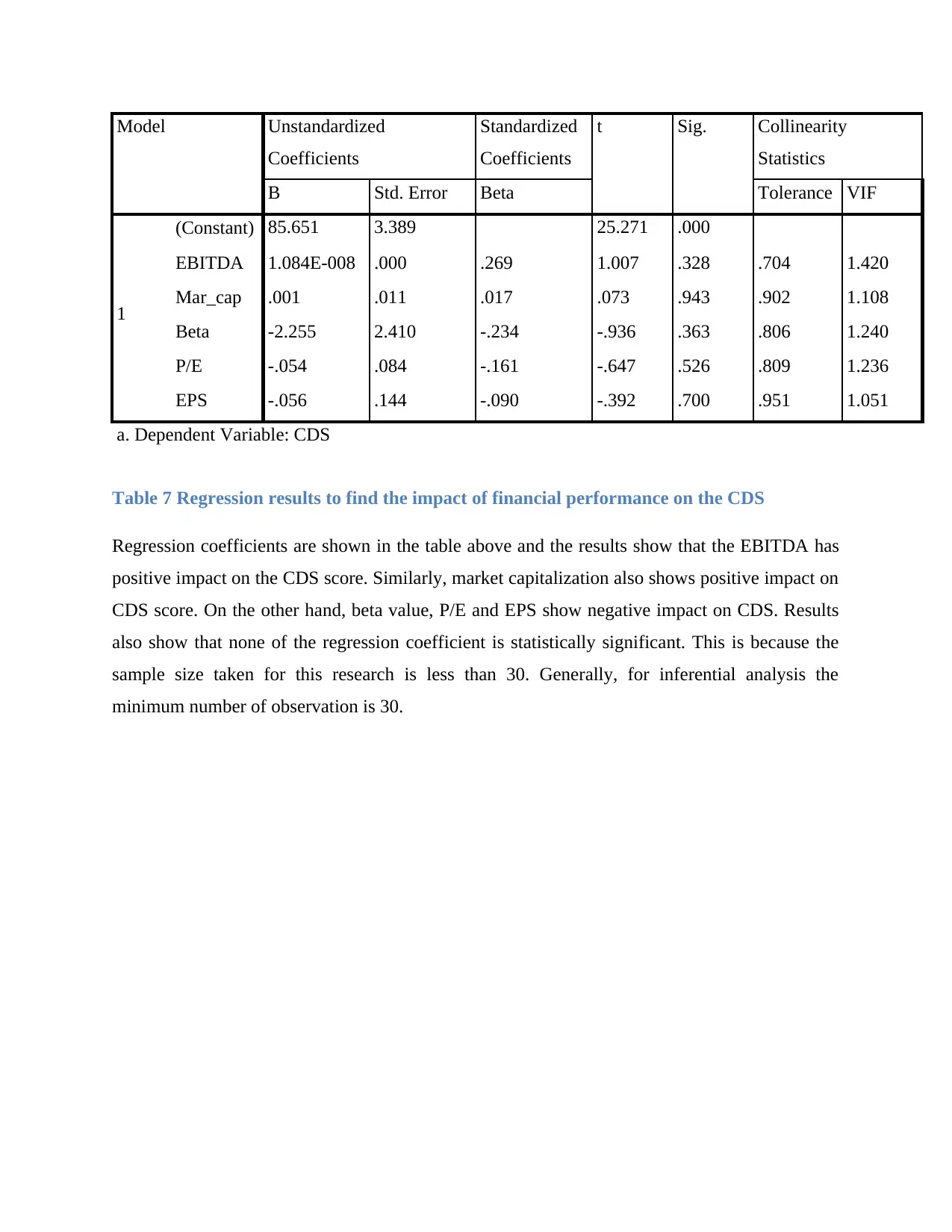
Model Unstandardized
Coefficients
Standardized
Coefficients
t Sig. Collinearity
Statistics
B Std. Error Beta Tolerance VIF
1
(Constant) 85.651 3.389 25.271 .000
EBITDA 1.084E-008 .000 .269 1.007 .328 .704 1.420
Mar_cap .001 .011 .017 .073 .943 .902 1.108
Beta -2.255 2.410 -.234 -.936 .363 .806 1.240
P/E -.054 .084 -.161 -.647 .526 .809 1.236
EPS -.056 .144 -.090 -.392 .700 .951 1.051
a. Dependent Variable: CDS
Table 7 Regression results to find the impact of financial performance on the CDS
Regression coefficients are shown in the table above and the results show that the EBITDA has
positive impact on the CDS score. Similarly, market capitalization also shows positive impact on
CDS score. On the other hand, beta value, P/E and EPS show negative impact on CDS. Results
also show that none of the regression coefficient is statistically significant. This is because the
sample size taken for this research is less than 30. Generally, for inferential analysis the
minimum number of observation is 30.
Coefficients
Standardized
Coefficients
t Sig. Collinearity
Statistics
B Std. Error Beta Tolerance VIF
1
(Constant) 85.651 3.389 25.271 .000
EBITDA 1.084E-008 .000 .269 1.007 .328 .704 1.420
Mar_cap .001 .011 .017 .073 .943 .902 1.108
Beta -2.255 2.410 -.234 -.936 .363 .806 1.240
P/E -.054 .084 -.161 -.647 .526 .809 1.236
EPS -.056 .144 -.090 -.392 .700 .951 1.051
a. Dependent Variable: CDS
Table 7 Regression results to find the impact of financial performance on the CDS
Regression coefficients are shown in the table above and the results show that the EBITDA has
positive impact on the CDS score. Similarly, market capitalization also shows positive impact on
CDS score. On the other hand, beta value, P/E and EPS show negative impact on CDS. Results
also show that none of the regression coefficient is statistically significant. This is because the
sample size taken for this research is less than 30. Generally, for inferential analysis the
minimum number of observation is 30.
⊘ This is a preview!⊘
Do you want full access?
Subscribe today to unlock all pages.

Trusted by 1+ million students worldwide
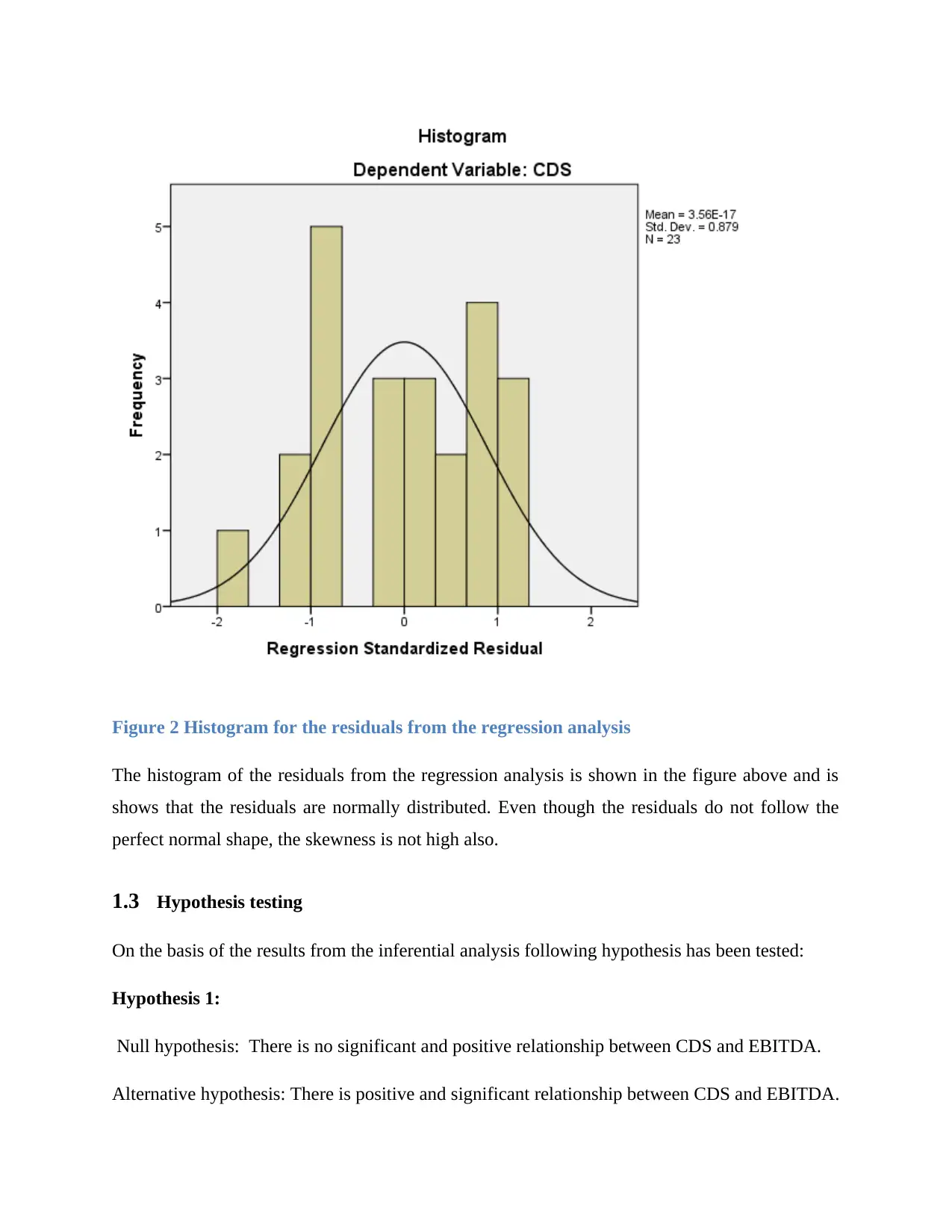
Figure 2 Histogram for the residuals from the regression analysis
The histogram of the residuals from the regression analysis is shown in the figure above and is
shows that the residuals are normally distributed. Even though the residuals do not follow the
perfect normal shape, the skewness is not high also.
1.3 Hypothesis testing
On the basis of the results from the inferential analysis following hypothesis has been tested:
Hypothesis 1:
Null hypothesis: There is no significant and positive relationship between CDS and EBITDA.
Alternative hypothesis: There is positive and significant relationship between CDS and EBITDA.
The histogram of the residuals from the regression analysis is shown in the figure above and is
shows that the residuals are normally distributed. Even though the residuals do not follow the
perfect normal shape, the skewness is not high also.
1.3 Hypothesis testing
On the basis of the results from the inferential analysis following hypothesis has been tested:
Hypothesis 1:
Null hypothesis: There is no significant and positive relationship between CDS and EBITDA.
Alternative hypothesis: There is positive and significant relationship between CDS and EBITDA.
Paraphrase This Document
Need a fresh take? Get an instant paraphrase of this document with our AI Paraphraser
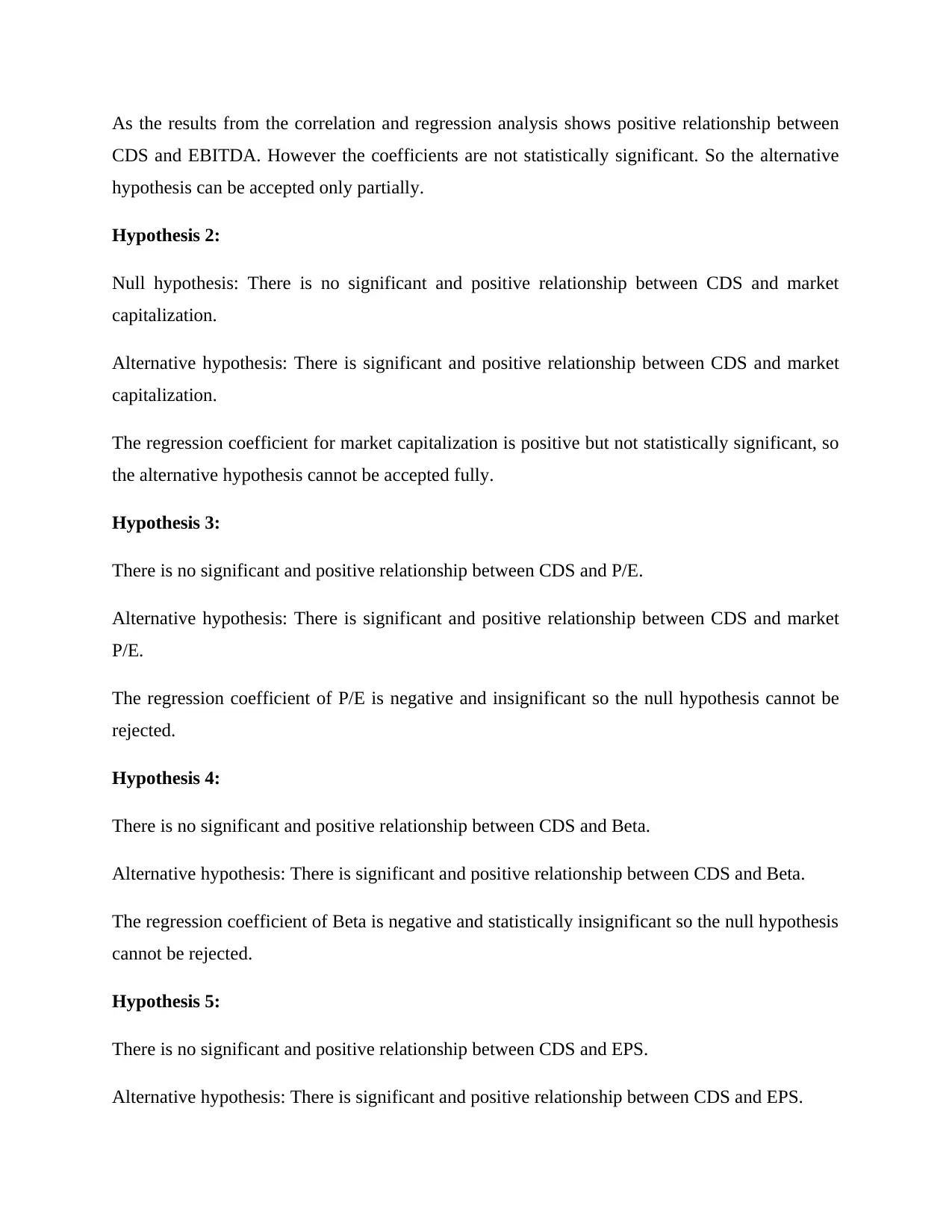
As the results from the correlation and regression analysis shows positive relationship between
CDS and EBITDA. However the coefficients are not statistically significant. So the alternative
hypothesis can be accepted only partially.
Hypothesis 2:
Null hypothesis: There is no significant and positive relationship between CDS and market
capitalization.
Alternative hypothesis: There is significant and positive relationship between CDS and market
capitalization.
The regression coefficient for market capitalization is positive but not statistically significant, so
the alternative hypothesis cannot be accepted fully.
Hypothesis 3:
There is no significant and positive relationship between CDS and P/E.
Alternative hypothesis: There is significant and positive relationship between CDS and market
P/E.
The regression coefficient of P/E is negative and insignificant so the null hypothesis cannot be
rejected.
Hypothesis 4:
There is no significant and positive relationship between CDS and Beta.
Alternative hypothesis: There is significant and positive relationship between CDS and Beta.
The regression coefficient of Beta is negative and statistically insignificant so the null hypothesis
cannot be rejected.
Hypothesis 5:
There is no significant and positive relationship between CDS and EPS.
Alternative hypothesis: There is significant and positive relationship between CDS and EPS.
CDS and EBITDA. However the coefficients are not statistically significant. So the alternative
hypothesis can be accepted only partially.
Hypothesis 2:
Null hypothesis: There is no significant and positive relationship between CDS and market
capitalization.
Alternative hypothesis: There is significant and positive relationship between CDS and market
capitalization.
The regression coefficient for market capitalization is positive but not statistically significant, so
the alternative hypothesis cannot be accepted fully.
Hypothesis 3:
There is no significant and positive relationship between CDS and P/E.
Alternative hypothesis: There is significant and positive relationship between CDS and market
P/E.
The regression coefficient of P/E is negative and insignificant so the null hypothesis cannot be
rejected.
Hypothesis 4:
There is no significant and positive relationship between CDS and Beta.
Alternative hypothesis: There is significant and positive relationship between CDS and Beta.
The regression coefficient of Beta is negative and statistically insignificant so the null hypothesis
cannot be rejected.
Hypothesis 5:
There is no significant and positive relationship between CDS and EPS.
Alternative hypothesis: There is significant and positive relationship between CDS and EPS.

The regression coefficient of EPS is negative and insignificant so the null hypothesis cannot be
rejected.
1.4 Discussion
Results from the ANOVA test shows that there is no statistical difference in CDS score for good
performing companies and the bad performing companies. This shows that the results do not
follow the legitimacy theory at least for the companies included in the current research. Similarly
the results from the correlation analysis show that the CDS and the EBITDA is positively
correlated, whereas correlation between EBITDA and beta is negative. However previous
researches on similar topic show positive relationship between the financial performance and the
CDS score(Mousa & Hassan 2015; Najah & Cotter 2010; Sharfman & Fernando 2008; Reid &
Toffel 2009; Smith et al. 2008). Results from the regression analysis also show that the CDS is
positively affected by the EBITDA. In other words with increase in profit before tax the CDS
score also increases. Companies performing financially well are expected to fulfill their
corporate social responsibility as compared to those who do not perform well. Also in some
countries companies are obliged to spend some proportion of profits for corporate responsibility
which also includes the environmental sustainability. Previous studies on the similar issues also
show similar results(Singh 2014; Omran & Ramdhony 2015; Clarkson et al. 2008; Clarkson et
al. 2011; Beatty & Shimshack 2010; Plumlee et al. 2008). However the results in the current
research are not statistically significant as the sample size is low.
1.5 Limitations
There are some limitations associated with the current research. One of the major problems is
small sample size. Since the minimum sample size required for t test is 30, which is not the case
in the current research. Apart from that only the quantitative research is conducted to find the
relationship between the CDS score and the EBITDA. However to get further information
qualitative analysis is considered to be more appropriate. Among the statistical techniques only
correlation and regression analysis is conducted, however there other statistical tools such as the
co-integration and causality test which could have been performed. Lastly there were limitations
related to the cost and time invested in the current research.
rejected.
1.4 Discussion
Results from the ANOVA test shows that there is no statistical difference in CDS score for good
performing companies and the bad performing companies. This shows that the results do not
follow the legitimacy theory at least for the companies included in the current research. Similarly
the results from the correlation analysis show that the CDS and the EBITDA is positively
correlated, whereas correlation between EBITDA and beta is negative. However previous
researches on similar topic show positive relationship between the financial performance and the
CDS score(Mousa & Hassan 2015; Najah & Cotter 2010; Sharfman & Fernando 2008; Reid &
Toffel 2009; Smith et al. 2008). Results from the regression analysis also show that the CDS is
positively affected by the EBITDA. In other words with increase in profit before tax the CDS
score also increases. Companies performing financially well are expected to fulfill their
corporate social responsibility as compared to those who do not perform well. Also in some
countries companies are obliged to spend some proportion of profits for corporate responsibility
which also includes the environmental sustainability. Previous studies on the similar issues also
show similar results(Singh 2014; Omran & Ramdhony 2015; Clarkson et al. 2008; Clarkson et
al. 2011; Beatty & Shimshack 2010; Plumlee et al. 2008). However the results in the current
research are not statistically significant as the sample size is low.
1.5 Limitations
There are some limitations associated with the current research. One of the major problems is
small sample size. Since the minimum sample size required for t test is 30, which is not the case
in the current research. Apart from that only the quantitative research is conducted to find the
relationship between the CDS score and the EBITDA. However to get further information
qualitative analysis is considered to be more appropriate. Among the statistical techniques only
correlation and regression analysis is conducted, however there other statistical tools such as the
co-integration and causality test which could have been performed. Lastly there were limitations
related to the cost and time invested in the current research.
⊘ This is a preview!⊘
Do you want full access?
Subscribe today to unlock all pages.

Trusted by 1+ million students worldwide
1 out of 14
Related Documents
Your All-in-One AI-Powered Toolkit for Academic Success.
+13062052269
info@desklib.com
Available 24*7 on WhatsApp / Email
![[object Object]](/_next/static/media/star-bottom.7253800d.svg)
Unlock your academic potential
Copyright © 2020–2025 A2Z Services. All Rights Reserved. Developed and managed by ZUCOL.





